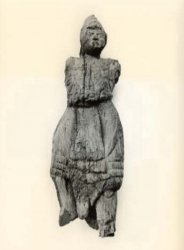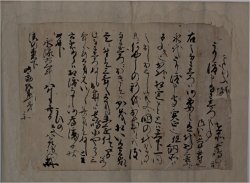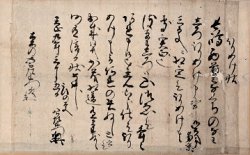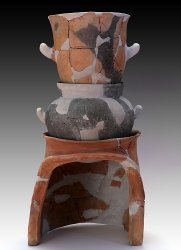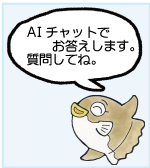境港市指定文化財の概要(2)
8)外江補岩寺毘沙門天像(Tonoe Hogan Temple Bishamonten Statue)
■分類:有形文化財(彫刻)
■指定年月日:平成4年6月10日
補岩寺の阿弥陀堂内に上記の阿弥陀如来座像と共に毘沙門天像が祀られている。
毘沙門天像は、像高106センチメートルの一木造で、平安時代後期のものと推定される。右足を少し上げてやや左を向いた姿から、現在は失われているが、もとは邪鬼を踏んで右手に武器を持ち、左手に宝塔を捧げた姿であったと考えられる。像の右側が黒く焦げており、いつの時代か火災に遭難されたであろう古い歴史がしのばれる。
■公開状況:非公開
■所在地:外江町 補岩寺内
■アクセス方法:JR境港駅から約2.3km、徒歩30分
■指定年月日:平成4年6月10日
補岩寺の阿弥陀堂内に上記の阿弥陀如来座像と共に毘沙門天像が祀られている。
毘沙門天像は、像高106センチメートルの一木造で、平安時代後期のものと推定される。右足を少し上げてやや左を向いた姿から、現在は失われているが、もとは邪鬼を踏んで右手に武器を持ち、左手に宝塔を捧げた姿であったと考えられる。像の右側が黒く焦げており、いつの時代か火災に遭難されたであろう古い歴史がしのばれる。
■公開状況:非公開
■所在地:外江町 補岩寺内
■アクセス方法:JR境港駅から約2.3km、徒歩30分
■ Classification: Tangible cultural property (sculpture)
■ Designated date: June 10,
■ Designated date: June 10,
1992 Bishamonten statue is enshrined in the Amida temple of Hoiwaji along with the above Amida Nyorai statue.
The Bishamonten statue is a wooden structure with a height of 106 cm and is estimated to be from the late Heian period. It is now lost because it turned slightly to the left with its right foot raised a little, but it is probable that it was originally a figure that stepped on an evil demon, held a weapon in his right hand, and dedicated a treasure tower to his left hand. The right side of the statue is charred black, showing the old history of a fire that might have been lost sometime.
The Bishamonten statue is a wooden structure with a height of 106 cm and is estimated to be from the late Heian period. It is now lost because it turned slightly to the left with its right foot raised a little, but it is probable that it was originally a figure that stepped on an evil demon, held a weapon in his right hand, and dedicated a treasure tower to his left hand. The right side of the statue is charred black, showing the old history of a fire that might have been lost sometime.
■ Public status: Private
■ Location: Hoiwa Temple, Tonoe-cho
■ Access method: Approximately 2.3km from JR Sakaiminato Station, 30 minutes on foot
■ Location: Hoiwa Temple, Tonoe-cho
■ Access method: Approximately 2.3km from JR Sakaiminato Station, 30 minutes on foot
9)瀬崎弥陀仏応安四年造仏銘記及び棟札(Mida Sezaki Buddha Oan 4th Year Buddha Inscription and Building Tag)
■分類:有形文化財(古文書)
■指定年月日:平成4年6月10日
瀬崎阿弥陀堂のあるあたり境水道の東入口西岸一帯は、古くから「瀬先」と呼ばれていた。ここに、阿弥陀堂があり、本尊阿弥陀仏を祀っている。本尊の胎内に奉内されていた古文書は、縦×横の大きさ29×36センチメートルの一枚文書で、次のように記されている。
「阿弥陀如来尊像 祐好刻之
追鐘寺 信心 施主(人名の部分欠損)
応安四年亥八月吉日 」
応安四年(1371)の年号は、南北朝時代の北朝年号であり、鎌倉時代から室町時代へと移る過程の動乱の時代である。
この応安四年の造仏銘記は、境港市内に残されている古文書の中でも最古の記録であり、郷土の歴史と信仰を知る上で貴重な存在である。
また、堂内には近世以降の棟札も大切に残されている。
■公開状況:非公開
■所在地:朝日町 瀬崎阿弥陀堂内
■アクセス方法:JR境港駅から約1.5km、徒歩19分
■仏銘記及び棟札[pdf:256KB]
■指定年月日:平成4年6月10日
瀬崎阿弥陀堂のあるあたり境水道の東入口西岸一帯は、古くから「瀬先」と呼ばれていた。ここに、阿弥陀堂があり、本尊阿弥陀仏を祀っている。本尊の胎内に奉内されていた古文書は、縦×横の大きさ29×36センチメートルの一枚文書で、次のように記されている。
「阿弥陀如来尊像 祐好刻之
追鐘寺 信心 施主(人名の部分欠損)
応安四年亥八月吉日 」
応安四年(1371)の年号は、南北朝時代の北朝年号であり、鎌倉時代から室町時代へと移る過程の動乱の時代である。
この応安四年の造仏銘記は、境港市内に残されている古文書の中でも最古の記録であり、郷土の歴史と信仰を知る上で貴重な存在である。
また、堂内には近世以降の棟札も大切に残されている。
■公開状況:非公開
■所在地:朝日町 瀬崎阿弥陀堂内
■アクセス方法:JR境港駅から約1.5km、徒歩19分
■ Classification: Tangible cultural property (old document)
■ Designated date: June 10,
■ Designated date: June 10,
1992 The area around the east entrance of the Sakai Suido , where Sezaki Amidado is located, has long been called "Sezaki". There is Amida-do here, which enshrines the principal image of Amida Buddha. The ancient document that was enshrined in the womb of the principal image is a single document measuring 29 x 36 cm in length and width, and is written as follows.
"Amida Nyorai statue Yuyoshi Kokuno Oganeji
Shinshin owner (partial loss of person's name) Oan
4th year August Yoshiday" The year of Oan
4th year (1371) is the Northern Court year of the Nanbokucho period, from the Kamakura period. It is an era of turmoil in the process of moving to the Muromachi period.
This Oan 4th year Buddhist inscription is the oldest record of ancient documents left in Sakaiminato City, and is a valuable presence for understanding the history and beliefs of the region.
In addition, the building tags from the early modern period are also carefully left in the hall.
"Amida Nyorai statue Yuyoshi Kokuno Oganeji
Shinshin owner (partial loss of person's name) Oan
4th year August Yoshiday" The year of Oan
4th year (1371) is the Northern Court year of the Nanbokucho period, from the Kamakura period. It is an era of turmoil in the process of moving to the Muromachi period.
This Oan 4th year Buddhist inscription is the oldest record of ancient documents left in Sakaiminato City, and is a valuable presence for understanding the history and beliefs of the region.
In addition, the building tags from the early modern period are also carefully left in the hall.
■ Public status: Private
■ Location: Asahimachi Sezaki Amidado
■ Access method: Approximately 1.5km from JR Sakaiminato Station, 19 minutes on foot
■ Location: Asahimachi Sezaki Amidado
■ Access method: Approximately 1.5km from JR Sakaiminato Station, 19 minutes on foot
10)上道稲賀家うりけん状(Agarimichi Inaga family Uriken Letter)
■分類:有形文化財(古文書)
■指定年月日:平成4年6月10日
この文書が書かれた永禄6年(1563)のころは、戦国の時代と呼ばれており、世の中は騒然としていた。
この時代の弓浜地方は、一面に砂丘が広がり、用水に恵まれず苗代も出来なかった。そのため、対岸の森山村に苗代田を求めて苗代を作ってきた。この文書は、森山村宇井の太夫・八郎左衛門が浜の松下の五郎左衛門に苗代田を3貫文で売り渡した売却証文である。中世の文書は、まれにしか発見されない。特に郷土の地方文書は、郷土史の研究に欠くことが出来ない貴重な資料である。
■公開状況:非公開
■所在地:海とくらしの史料館
■アクセス方法:JR境港駅から約2km、徒歩25分
■指定年月日:平成4年6月10日
この文書が書かれた永禄6年(1563)のころは、戦国の時代と呼ばれており、世の中は騒然としていた。
この時代の弓浜地方は、一面に砂丘が広がり、用水に恵まれず苗代も出来なかった。そのため、対岸の森山村に苗代田を求めて苗代を作ってきた。この文書は、森山村宇井の太夫・八郎左衛門が浜の松下の五郎左衛門に苗代田を3貫文で売り渡した売却証文である。中世の文書は、まれにしか発見されない。特に郷土の地方文書は、郷土史の研究に欠くことが出来ない貴重な資料である。
■公開状況:非公開
■所在地:海とくらしの史料館
■アクセス方法:JR境港駅から約2km、徒歩25分
■ Classification: Tangible Cultural Property (Old Document)
■ Designated Date: June 10, 1992
■ Designated Date: June 10, 1992
The time when this document was written in Eiroku 6 (1563) was called the Warring States period, and the world Was noisy.
In the Yuhama region of this era, sand dunes spread all over, and we were not blessed with water and could not afford seedlings. For this reason, we have been seeking seedlings in Moriyama Village on the opposite bank. This document is a certificate of sale that Tayu Hachirozaemon of Moriyama Village Ui sold Naedaita to Gorozaemon of Matsushita on the beach in three sentences. Medieval documents are rarely found. In particular, local documents are valuable materials that are indispensable for studying local history.
In the Yuhama region of this era, sand dunes spread all over, and we were not blessed with water and could not afford seedlings. For this reason, we have been seeking seedlings in Moriyama Village on the opposite bank. This document is a certificate of sale that Tayu Hachirozaemon of Moriyama Village Ui sold Naedaita to Gorozaemon of Matsushita on the beach in three sentences. Medieval documents are rarely found. In particular, local documents are valuable materials that are indispensable for studying local history.
■ Public status: Private
■ Location: Umi to Kurashi Museum
■ Access method: Approximately 2km from JR Sakaiminato Station, 25 minutes on foot
■ Location: Umi to Kurashi Museum
■ Access method: Approximately 2km from JR Sakaiminato Station, 25 minutes on foot
11)中野佐々木家ほりあけ状(Nakano Sasaki family Horiake Letter)
■分類:有形文化財(古文書)
■指定年月日:平成4年6月10日
稲賀家蔵の「うりけん状」より18年後の天正9年(1581)に、森山村宇井の太夫八郎左衛門と、浜の松下の五郎左衛門が取り交わした土地関係文書である。
この文書の特徴は、森山村長島の山崩れによって荒れている所を代金を支払って掘りあげ、苗代田に仕立てたことを証明していることと、文書の差出人と受取人が「うりけん状」と同一人物であることである。このような記録は他にも多くあったはずである。しかし、長い年月の間に散逸してしまったことであろう。森山村に苗代を借りて苗を育て、稲は自家水田で栽培するという、弓浜農業の実態を探る手掛かりとして貴重な文献である。
■公開状況:非公開
■所在地:海とくらしの史料館
■アクセス方法:JR境港駅から約2km、徒歩25分
■指定年月日:平成4年6月10日
稲賀家蔵の「うりけん状」より18年後の天正9年(1581)に、森山村宇井の太夫八郎左衛門と、浜の松下の五郎左衛門が取り交わした土地関係文書である。
この文書の特徴は、森山村長島の山崩れによって荒れている所を代金を支払って掘りあげ、苗代田に仕立てたことを証明していることと、文書の差出人と受取人が「うりけん状」と同一人物であることである。このような記録は他にも多くあったはずである。しかし、長い年月の間に散逸してしまったことであろう。森山村に苗代を借りて苗を育て、稲は自家水田で栽培するという、弓浜農業の実態を探る手掛かりとして貴重な文献である。
■公開状況:非公開
■所在地:海とくらしの史料館
■アクセス方法:JR境港駅から約2km、徒歩25分
■ Classification: Tangible Cultural Property ( Old Document)
■ Designated Date: June 10,
■ Designated Date: June 10,
1992 In 1581, 18 years after the "Uriken Letter" in the Inaga family's collection, Tayu Moriyama Village Ui This is a land-related document exchanged between Hachirozaemon and Gorozaemon of Matsushita on the beach.
The features of this document are that it proves that it was made into a sapling by digging up the place that was damaged by the landslide of Nagashima, Moriyama village, and that the sender and recipient of the document are "Uriken-like". Is the same person as. There must have been many other records like this. However, it must have been dissipated over the years. It is a valuable document as a clue to explore the actual situation of Yuhama agriculture, where seedlings are rented from Moriyama Village to grow seedlings and rice is cultivated in private paddy fields.
The features of this document are that it proves that it was made into a sapling by digging up the place that was damaged by the landslide of Nagashima, Moriyama village, and that the sender and recipient of the document are "Uriken-like". Is the same person as. There must have been many other records like this. However, it must have been dissipated over the years. It is a valuable document as a clue to explore the actual situation of Yuhama agriculture, where seedlings are rented from Moriyama Village to grow seedlings and rice is cultivated in private paddy fields.
■ Public status: Private
■ Location: Umi to Kurashi Museum
■ Access method: Approximately 2km from JR Sakaiminato Station, 25 minutes on foot
■ Location: Umi to Kurashi Museum
■ Access method: Approximately 2km from JR Sakaiminato Station, 25 minutes on foot
12)清水町のこしき・かまど・土器群(Shimizu-cho's koshiki, kamado, and earthenware group)
■分類:有形文化財(考古資料)
■指定年月日:平成4年6月10日
昭和25年12月、市内清水町矢尻川附近の地下2メートルの砂層から検出された古墳時代後期の遺物である。
甑(コシキ)、釜(カマ)、竃(カマド)の三品がそろっているのは珍しく、古代人の生活や生業を知る上で貴重な資料である。
土師器の竃の上に須恵器の釜が載り、その上に下部に蒸気穴のある甑を置く蒸し器のセットである。釜の底部は黒く焼けた跡がある。この三点を組み立てた高さは約80センチである。
土師器は、弥生式土器の流れをくむ黄褐色または赤褐色の土器で、整形された粘土素地を大気中の酸化焔で焼成されるため、多孔質で硬化の度合は低い。これに対し、須恵器は半密閉の竃の還元焔で、時間をかけて焼かれるので、陶器に近い硬さをもつ帯青灰色の土器である。祭祀供献の器が多く、祝部土器ともいわれる。朝鮮半島南部から伝来の技法で、百済、新羅から渡来の帰化工人の手になるものといわれる。轆轤を使うなど制作技術は土師器より高度である。
これらの土器が出土した清水地区は、弓浜地区でも古くから開けた土地で、豊富な地下水脈があり、湧水もあって、耕地も開発され、周辺に広く散在する土器片包含地の分布などから、かなり成熟した村落や住居が各所に成立していたと考えられる。
■公開状況:公開
■所在地:海とくらしの史料館
■アクセス方法:JR境港駅から約2km、徒歩25分
■指定年月日:平成4年6月10日
昭和25年12月、市内清水町矢尻川附近の地下2メートルの砂層から検出された古墳時代後期の遺物である。
甑(コシキ)、釜(カマ)、竃(カマド)の三品がそろっているのは珍しく、古代人の生活や生業を知る上で貴重な資料である。
土師器の竃の上に須恵器の釜が載り、その上に下部に蒸気穴のある甑を置く蒸し器のセットである。釜の底部は黒く焼けた跡がある。この三点を組み立てた高さは約80センチである。
土師器は、弥生式土器の流れをくむ黄褐色または赤褐色の土器で、整形された粘土素地を大気中の酸化焔で焼成されるため、多孔質で硬化の度合は低い。これに対し、須恵器は半密閉の竃の還元焔で、時間をかけて焼かれるので、陶器に近い硬さをもつ帯青灰色の土器である。祭祀供献の器が多く、祝部土器ともいわれる。朝鮮半島南部から伝来の技法で、百済、新羅から渡来の帰化工人の手になるものといわれる。轆轤を使うなど制作技術は土師器より高度である。
これらの土器が出土した清水地区は、弓浜地区でも古くから開けた土地で、豊富な地下水脈があり、湧水もあって、耕地も開発され、周辺に広く散在する土器片包含地の分布などから、かなり成熟した村落や住居が各所に成立していたと考えられる。
■公開状況:公開
■所在地:海とくらしの史料館
■アクセス方法:JR境港駅から約2km、徒歩25分
■ Classification: Tangible cultural property (archaeological material)
■ Designated date: June 10,
■ Designated date: June 10,
1992 In December 1950, the late Kofun period was detected in a sand layer 2 meters underground near the Yajiri River in Shimizu Town in the city. It is a relic.
It is rare to have three items, Koshiki, Kama, and Kamado, which are valuable materials for learning about the lives and livelihoods of ancient people.
It is a set of steamers in which a pot of Sue pottery is placed on a pot of Haji pottery, and a pottery with a steam hole is placed on it. The bottom of the kettle has a black burn mark. The height of the assembled three points is about 80 cm.
Haji pottery is a tan or reddish-brown pottery that follows the flow of Yayoi pottery, and is porous and has a low degree of hardening because the shaped clay base is fired by oxidative flame in the atmosphere. On the other hand, Sue pottery is a semi-enclosed kamado reduction flame, which is baked over time, so it is a blue-gray earthenware with a hardness close to that of pottery. There are many ritual offerings, and it is also called a celebration pottery. It is a technique introduced from the southern part of the Korean Peninsula, and is said to be in the hands of naturalized workers from Baekje and Silla. The production technique is more advanced than Haji pottery, such as using the potter's wheel.
The Shimizu area, where these pottery was excavated, is a land that has been open for a long time even in the Yuhama area, and has abundant groundwater veins, spring water, cultivated land, and a distribution of pottery pieces that are widely scattered around From the above, it is probable that fairly mature villages and dwellings were established in various places.
It is rare to have three items, Koshiki, Kama, and Kamado, which are valuable materials for learning about the lives and livelihoods of ancient people.
It is a set of steamers in which a pot of Sue pottery is placed on a pot of Haji pottery, and a pottery with a steam hole is placed on it. The bottom of the kettle has a black burn mark. The height of the assembled three points is about 80 cm.
Haji pottery is a tan or reddish-brown pottery that follows the flow of Yayoi pottery, and is porous and has a low degree of hardening because the shaped clay base is fired by oxidative flame in the atmosphere. On the other hand, Sue pottery is a semi-enclosed kamado reduction flame, which is baked over time, so it is a blue-gray earthenware with a hardness close to that of pottery. There are many ritual offerings, and it is also called a celebration pottery. It is a technique introduced from the southern part of the Korean Peninsula, and is said to be in the hands of naturalized workers from Baekje and Silla. The production technique is more advanced than Haji pottery, such as using the potter's wheel.
The Shimizu area, where these pottery was excavated, is a land that has been open for a long time even in the Yuhama area, and has abundant groundwater veins, spring water, cultivated land, and a distribution of pottery pieces that are widely scattered around From the above, it is probable that fairly mature villages and dwellings were established in various places.
■ Public status: Public
■ Location: Umi to Kurashi Museum
■ Access method: Approximately 2km from JR Sakaiminato Station, 25 minutes on foot
■ Location: Umi to Kurashi Museum
■ Access method: Approximately 2km from JR Sakaiminato Station, 25 minutes on foot
13)井田磐山墓とその遺品(Ida Banzan Tomb and its relics)
■分類:記念物(史跡)及び有形文化財(歴史資料)
■指定年月日:平成4年6月10日
井田磐山は明和9年(1769)大篠津村に生まれ、佐斐神村の井田家に入った。若くして書を好み、書法を求めて京都に上った。
書の奥義を極めた磐山は、書をもって諸国を尋ね書を教えている。
嘉永元年(1848)5月、書をもって法橋の位を授けられた。同年7月比叡山法曼陀羅院の額を揮毫し、その功によって法眼に叙された。さらに嘉永3年(1850)5月、山門の屏風に揮毫、法印に補され苗字帶刀を許される。書家として破格の処遇を受けている。
晩年は郷里へ帰り、龍泉寺の寺号、山号をはじめ文久3年(1863)94歳の生涯を終えるまで、雄勁にして力強い作品を多く残している。
■公開状況:非公開
■所在地:小篠津町 幸神町墓苑内、小篠津町 龍泉寺内
■アクセス方法:JR中浜駅から約850m、徒歩11分
■指定年月日:平成4年6月10日
井田磐山は明和9年(1769)大篠津村に生まれ、佐斐神村の井田家に入った。若くして書を好み、書法を求めて京都に上った。
書の奥義を極めた磐山は、書をもって諸国を尋ね書を教えている。
嘉永元年(1848)5月、書をもって法橋の位を授けられた。同年7月比叡山法曼陀羅院の額を揮毫し、その功によって法眼に叙された。さらに嘉永3年(1850)5月、山門の屏風に揮毫、法印に補され苗字帶刀を許される。書家として破格の処遇を受けている。
晩年は郷里へ帰り、龍泉寺の寺号、山号をはじめ文久3年(1863)94歳の生涯を終えるまで、雄勁にして力強い作品を多く残している。
■公開状況:非公開
■所在地:小篠津町 幸神町墓苑内、小篠津町 龍泉寺内
■アクセス方法:JR中浜駅から約850m、徒歩11分
■ Classification: Monuments (historic sites) and tangible cultural properties (historical materials)
■ Designated date: June 10, 1992
■ Designated date: June 10, 1992
Ida Iwayama was born in Oshinozu Village in 1769, and the Ida family in Sakai Kamimura. entered in. He liked calligraphy at a young age and went up to Kyoto in search of calligraphy.
Iwayama, who has mastered the mystery of the calligraphy, asks the countries with the calligraphy and teaches the calligraphy.
In May of the first year of Kaei (1848), he was awarded the rank of Hobashi with a calligraphy. In July of the same year, the forehead of Mt. Hiei Homandala-in was voluntarily struck, and due to its achievements, it was hailed as a lawyer. Furthermore, in May 1850 (Kaei 3), he was allowed to use a surname sword, supplemented by a folding screen at the Sanmon gate. He has been treated exceptionally as a calligrapher.
In his later years, he returned to his hometown and left many powerful works as a hero until the end of his life at the age of 94 in 1863, including the temple and sango of Ryusenji.
Iwayama, who has mastered the mystery of the calligraphy, asks the countries with the calligraphy and teaches the calligraphy.
In May of the first year of Kaei (1848), he was awarded the rank of Hobashi with a calligraphy. In July of the same year, the forehead of Mt. Hiei Homandala-in was voluntarily struck, and due to its achievements, it was hailed as a lawyer. Furthermore, in May 1850 (Kaei 3), he was allowed to use a surname sword, supplemented by a folding screen at the Sanmon gate. He has been treated exceptionally as a calligrapher.
In his later years, he returned to his hometown and left many powerful works as a hero until the end of his life at the age of 94 in 1863, including the temple and sango of Ryusenji.
■ Public status: Private
■ Location: Koshinozucho Kojincho Tomb Garden, Koshinozucho Ryusenji
■ Access: Approximately 850m from JR Nakahama Station, 11 minutes on foot
■ Location: Koshinozucho Kojincho Tomb Garden, Koshinozucho Ryusenji
■ Access: Approximately 850m from JR Nakahama Station, 11 minutes on foot
問い合わせ先(Contact)
生涯学習課文化体育係(0859-47-1093)
Lifelong Learning Division Cultural and Physical Education Section (0859-47-1093)
Lifelong Learning Division Cultural and Physical Education Section (0859-47-1093)

